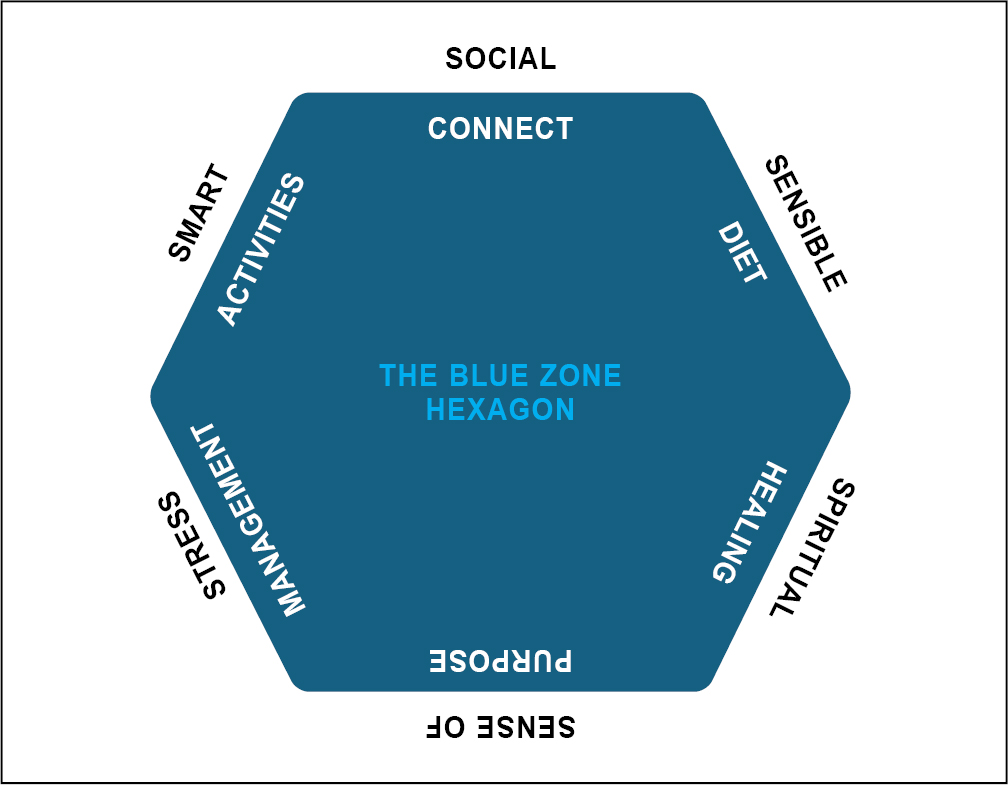Published in IJCP
July 2024
Guest Editorial
The Blue Zone Buzz: Learnings from the Blue Zone
July 16, 2024 | Ashish Chopra, Atul Mishra, Nitin Kapoor, Sanjay Kalra
Internal Medicine

Abstract
In various regions around the world, there exist pockets where people live exceptionally long and healthy lives, far exceeding the global average. These regions, known as Blue Zones, have garnered the attention of researchers and health enthusiasts alike, as they hold the key to unlocking the secrets of longevity and well-being. In this editorial, we explore the concept of Blue Zones, delving into their characteristics, lifestyle factors, and the lessons we can learn from these remarkable communities. We propose the evidence-based Blue Zone Hexagon, to highlight the actions and targets we can focus on, so as to make our country a Blue Zone country.
Keywords: Blue Zone, life expectancy, longevity, anti-aging, medical nutrition therapy
Blue Zones are regions or communities, as below, with a high concentration of individuals who live longer than the global population to become nonagenarians or centenarians.
- Loma Linda, USA
- Nicoya, Costa Rica
- Sardinia, Italy
- Icaria, Greece
- Okinawa, Japan
These regions across the globe have been explored by researchers, to identify the critical factors, which influence and promote this exceptional longevity1,2.
CHARACTERISTICS OF BLUE ZONES
- Strong social connections: One common characteristic of Blue Zones is the emphasis on social connections and a sense of community. People in these regions maintain close-knit relationships with family, friends, and neighbors, providing support, companionship, and a sense of belonging.
- Plant-based diets: Blue Zone inhabitants predominantly consume plant-based diets. Their meals consist of an abundance of fruits, vegetables, whole grains, legumes, and nuts. They limit their intake of processed foods, added sugars, and unhealthy fats, opting instead for nutrient-dense, locally sourced ingredients.
- Active lifestyles: Physical activity is an important and usual part of daily life in Blue Zones. Instead of depending on modern conveniences, inhabitants of the Blue Zones engage in natural movements through activities like walking, gardening, and manual labor. A daily engagement in physical activities keeps their bodies strong and agile.
- Stress reduction: Blue Zone communities prioritize stress management and relaxation techniques. They practice meditation, take regular breaks, and spend quality time with loved ones. Managing stress is believed to contribute to their overall well-being and longevity.
- Sense of purpose: One of the noteworthy factors of the Blue Zones is having a sense of purpose and meaning in life. Inhabitants often have a clear sense of their role within their families, communities, or society, which provides them with a reason to wake up each morning and a sense of fulfillment.
THE BLUE ZONE HEXAGON
There are many learnings from these Blue Zones that can be incorporated into our daily lifestyle to embrace improved quality of life and longevity.
The Blue Zone Hexagon (Fig. 1) is a pragmatic rubric of the action plans, which may be adopted by the individuals, families and communities. Six aspects of life namely sensible diet and smart activities; social connect and stress management; and sense of purpose and spiritual healing encapsulate the techniques as well as targets of becoming Blue Zone. The Blue Zone Hexagon is useful at both individual and public health levels. At a mega level, it will achieve our goal of making India the first Blue Zone country.

Figure 1. The Blue Zone Hexagon.
ROLE OF MEDICAL NUTRITION THERAPY
Diet is an integral part of Blue Zoning. As all of us cannot live in physically demarcated Blue Zones, it may be necessary to use physio-friendly, balanced medical nutrition therapy that is balanced and complete in not only mega- and macronutrients (fiber, carbohydrates, proteins, fat), but also adequate in micronutrients (vitamins, minerals, electrolytes)3,4. This should be accompanied by a conscious, concerted and continued focus on other aspects of healthy living, including structured physical activity, stress management, social health and spiritual upliftment.
The role of medical nutrition therapy is especially important in persons during vulnerable phases of life, like pregnancy and lactation5, as well as persons with pre-existing medical conditions, such as diabetes and obesity4. Moreover, the Blue Zone elements also highlight the need for including a balanced diet coupled with physical activity for prevention of chronic disorders6.
Blue Zones offer a glimpse into the secrets of longevity and well-being. By adopting the lifestyle practices observed in these remarkable communities, we can make positive changes in our own lives. Cultivating strong social connections, embracing a plant-based diet, staying active, managing stress, and finding a sense of purpose are all essential components of a long, healthy, and fulfilling life.
Let the wisdom of Blue Zone inspire us to make meaningful changes and embark on a journey toward improved well-being. Together we can make our community, and our country, a Blue Zone Community.
- Buettner D, Skemp S. Blue Zones: lessons from the world’s longest lived. Am J Lifestyle Med. 2016;10(5):318-21.
- Wendt J, Considine C, Kogan M. Blue Zone lessons and longevity diets. In: Wendt J, Considine C, Kogan M (Eds.). Integrative Geriatric Nutrition: A Practitioner’s Guide to Dietary Approaches for Older Adults. Springer, Cham; 2021. pp. 9-23.
- Kalra B, Choubey N, Kapoor N, Kalra S. Culinary counselling in chronic care: the Pentad of Cs & Ps. J Pak Med Assoc. 2023;73(2):428-9.
- Kapoor N, Sahay R, Kalra S, Bajaj S, Dasgupta A, Shrestha D, et al. Consensus on medical nutrition therapy for diabesity (CoMeND) in adults: a South Asian perspective. Diabetes Metab Syndr Obes. 2021;14:1703-28.
- Marshall NE, Abrams B, Barbour LA, Catalano P, Christian P, Friedman JE, et al. The importance of nutrition in pregnancy and lactation: lifelong consequences. Am J Obstet Gynecol. 2022;226(5):607-32.
- Kalra S, Verma M, Kapoor N. Exercise and physical activity diversity. J Pak Med Assoc. 2023;73(10):2116-7.
|